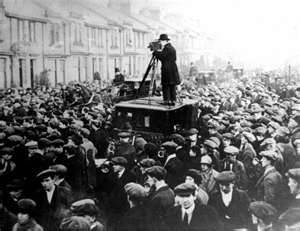Allan Armstrong argues that the saltire is not a symbol nor St. Andrews Day a celebration which republican socialists, or indeed anyone committed to a multi-ethnic and multi-faith (and non-faith) Scotland can see as their own. However, he points out that Scottish socialists can still make November 30th their own, whilst flying the red flag. This is an update an article Allan originally wrote for the Lothian SSP bulletin.
Many Socialists feel decidedly uneasy marching behind the saltire flag of the Nationalists. This is a Christian symbol, no longer appropriate for representing the people of a multi-ethnic, multi and non-faith Scotland. So, how did the saltire become the national flag and how did St. Andrew, whom the flag symbolises, become the patron saint of Scotland?

The usual explanation is the following. St. Andrew is meant to have been one of Jesus’ apostles. The saltire is in the form of the cross that St. Andrew was crucified on. When the kings of the Picts and Anglo-Saxon Northumbrians faced each other in battle, at Athelstaneford in East Lothian in 832 AD, clouds in the shape of a saltire appeared. The Pictish king took this as a good omen, and after his victory, it is claimed that he adopted the saltire as the national flag.
Unfortunately, Nationalist historians don’t look too closely at the nature of this battle, if it ever took place. There was no Scottish state at the time. Today’s Scotland was then divided between areas controlled by Picts, Scots in Dalriada, Welsh-speaking Britons and Anglo-Saxons – with the Vikings soon to be added to this mix. At Athelstaneford, Picts and Anglo-Saxons would have been fighting about who had the right of conquest over the Britons then living in the Lothians. A war of national liberation it was not.
There are other explanations. Some claim the adoption of St. Andrew as Scotland’s patron saint was an attempt by the Pictish kings to increase their authority. This meant Romanising a church, which traditionally had its own local Celtic saints, headed by St. Columba.
St. Andrew’s Day, held on November 30th, has become a semi-official national holiday in Scotland. Employers can grant a holiday on this day by ditching one of the existing local May holidays – not necessarily a popular move, given the comparison between the lengths of daylight hours and the weather on the two dates! Given that the UK has the fewest public holidays in Europe, another (paid) day would be most welcome.
However, is there an alternative Socialists can celebrate on November 30th? If we look to international workers day, May 1st, we can see a useful precedent. This date was originally declared to commemorate the Haymarket Martyrs, shot and killed in Chicago, in 1886, May 1st. In England though, this date had been a traditional day of celebration associated with morris dancers and maypoles.
Socialists did not try to get this celebration abolished, but tried to create something much bigger and more significant on that date. They were very successful too.

So what would socialists celebrate on November 30th? As it happens, this day marks the anniversary of the death of that great Scottish internationalist and workers’ republican, John Maclean. When Maclean died, in 1923, a 20,000 strong demonstration accompanied his funeral cortege to Eastwood Cemetary on the southside of Glasgow. Workers were commemorating his life of resistance and struggle.
Furthermore, it is thought that Maclean died of pneumonia, partly because he generously loaned his only overcoat to a visiting black socialist, Neil Johnston, from Barbados. Maclean put his internationalism into practice, whether over support for struggles in Ireland and India, or for overseas comrades visiting Scotland.
In recent years, the STUC has organised an anti-racist march to coincide with St. Andrew’s Day. How much more appropriate it would be for Socialists, if we were marching, red flags flying, on John Maclean Day.
